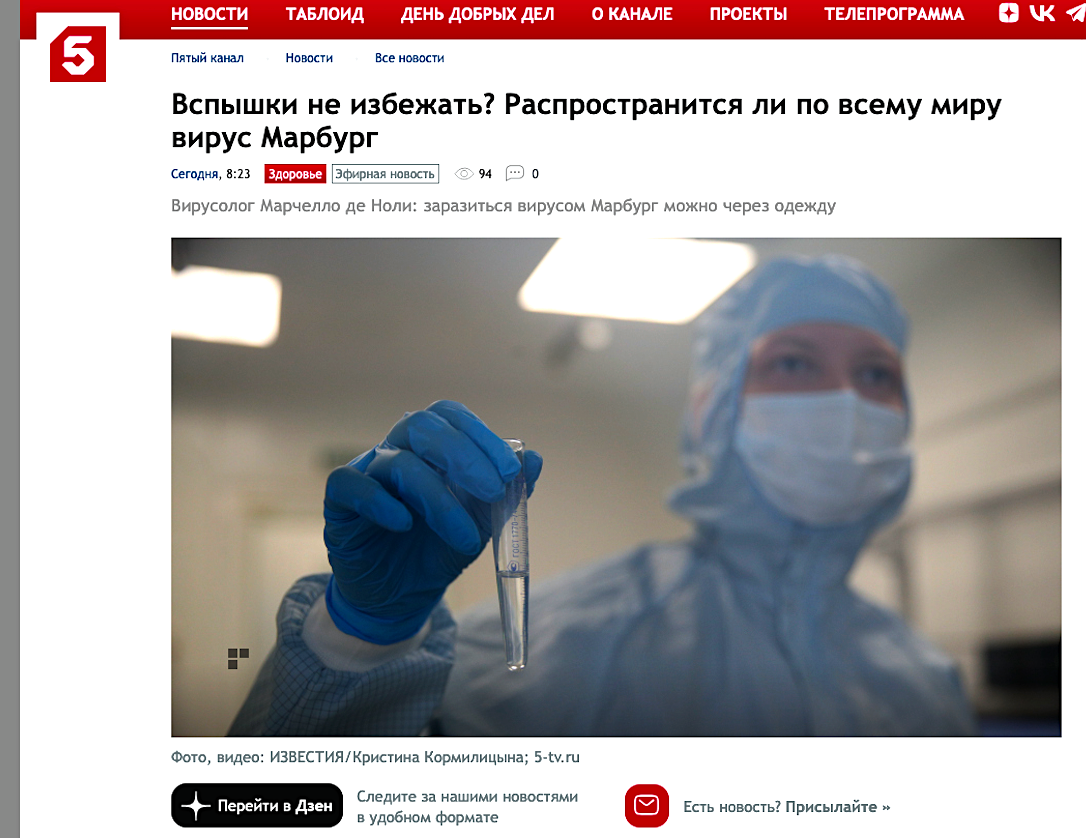No evidence Marburg virus is airborne, like COVID-19. However the case fatality rate for Marburg virus disease is much higher. It is reported that in certain areas of Africa can be reach up to 80%. In countries like in Europe –or others with a similar developed health care– mortality rate is much less, and estimated not higher than 40 percent.
Marburg virus is not transmitted airborne, but through direct contact of fluids from persons infected. Also, “if a person cough or sneezes, those respiratory droplets can spread the virus to a person who touches that surface, and then touches their eyes, or nose, mouth, etc.”
By Marcello Ferrada de Noli, professor emeritus of epidemiology (Sweden)
Note: Here below transcript (translated) of Outbreak Inevitable? “Will Marburg Virus Spread Worldwide? Epidemiologist Marcello de Noli: How Can Marburg Virus Be Infected Through Clothing”, an article in Channel 5, Russia, including segment of the interview yesterday done by Izvestia team with the author via Skype. The full interview to be posted here later.
Rwanda has already identified 26 cases of the disease, including eight deaths.
Rospotrebnadzor is monitoring the situation with the Marburg virus. At checkpoints across the state border, the agency’s specialists identify citizens with signs of infectious diseases, including those arriving from countries with an unfavorable epidemiological situation. In addition, a diagnostic test system has been prepared to reduce the risk of importing the disease to Russia.
Earlier, the World Health Organization (WHO) warned of the threat of a new Marburg virus epidemic – after 26 cases of the disease were identified in Rwanda, including eight deaths. So is the world facing another pandemic? Izvestia correspondent Pavel Matveyev found out everything.
A train stopped in Hamburg. A cordon, flashing lights. What happened?
“Two passengers arrived from abroad who showed signs of the disease. We are now transporting them to the clinic,” says Christian Wolter, a representative of the fire brigade.
The disease is called the Marburg virus, it was identified back in ’67, but now threatens to become a new COVID and arrived with those passengers from Rwanda.
“At the moment, we have confirmed 20 cases of the disease and six deaths that were caused by the Marburg virus,” says Rwandan Health Minister Sabin Nsanzimana.
Six deaths out of 20 cases. However, mortality from Marburg is not a new thing – 19 years ago in Angola, 200 people fell ill, 173 died. The question is in the ability of the virus to spread.
“Imported cases are potentially possible in Russia, no one can rule this out 100%. But this is unlikely, because we have a perimeter system, there are sanitary shields,” says Georgy Vikulov, director of the Research Center for the Prevention and Treatment of Viral Infections, University Clinic (MNOC) of Moscow State University.

But let’s remember how it all began in 2020. “A Chinese man ate a bat,” the world laughed. And the Chinese were already dying from the coronavirus in the thousands.
“In fact, it was very scary. At first we thought it was not serious, but then, after such a huge number of people died, we realized how serious it was,” says Huang Yu’er, a student from China.
Then the whole world felt the seriousness. But is there a reason to worry this time?
“WHO assesses the probability of the outbreak spreading around the world as low. The virus is not transmitted by airborne droplets. Infection is possible through direct contact with bodily fluids – with blood, through physical contact with an infected person, or through surfaces and materials that he touched,” says Stefan De Keersmeker, spokesman for the European Commission.
Through surfaces and materials – we’ve already been through this. Because of the coronavirus found on salmon skin – that’s also a surface, right?
“Yes, people can get infected, for example, through clothing, bath accessories, medical equipment. And if a person, for example, sneezes or coughs on their surface, it is very likely that the person who touches them will become infected,” says emeritus professor of epidemiology Marcello Ferada de Noli.
[NOTE: In the recorded interview I clarified: “if a person cough or sneezes, those respiratory droplets can spread the virus to a person who touches that surface, and then touches their eyes, or nose, mouth, etc.”]
Any virus can initially seem deadly, but turn out to be nonsense. Who remembers swine flu now? But it can be the other way around. And here the main question is the vaccine. If necessary, it can be ready in a year.
“In 2022, we received money, and not only made a vaccine against Marburg. It is polyvalent against Marburg and Ebola at the same time. Yes, and we completed the first stage of clinical trials,” says Alexander Ginzburg, director of the Gamaleya National Research Center for Epidemiology and Microbiology.
But “in a year” is also a period. Therefore, if the virus turns out to be serious, our contribution is needed.
Pay attention to the symptoms: fever, chills, headache, nausea. After a few days – diarrhea, rash on the shoulders and back, dehydration. And the main advice, tested by coronavirus – wash your hands.
